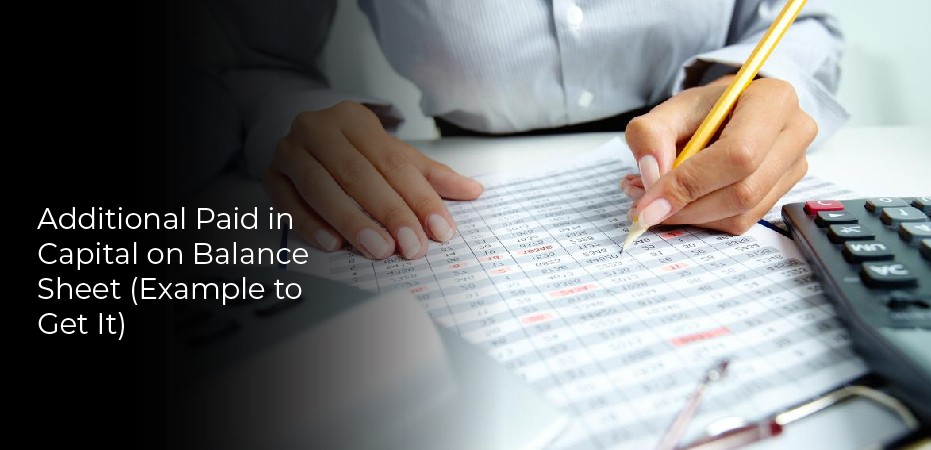Additional paid-in capital is a journal entry on a balance sheet that represents the amount that investors pay over par for a share of stock. It is also known as “share premium” and “capital surplus.” It represents the difference between the actual price of the share and its par value. The AdditionalPaid-in capital is used to measure a company’s profitability.
This capital is often higher than the stock’s par value, and financial analysts watch for this amount on balance sheets. The amount of AdditionalPaid-in capital is a sign of the degree of investor confidence and the prudent use of money. It is often a good idea to look for a company with a large APIC as a sign that it is managing its money well.
The article contains all the accounting details that basis on AdditionalPaid-in capital, and examples are available to understand the scenario.
What is Additional Paid in Capital?
AdditionalPaid-in capital (APIC) refers to the amount of capital a company has above its par value. This amount is reflected on the balance sheet. If a company purchased shares from the secondary market, those shares would not be included in its APIC. This amount is used to calculate a company’s earnings per share.
How Additional Paid-in Capital (APIC) Works
It is up to the firm to determine its stock price during its initial public offering. Additionally, investors may elect to pay any amount above this declared par value for a share, resulting in the APIC.
Suppose XYZ Widget Company issues one million shares of stock, each with a $1 par value, at IPO, and investors bid on these shares for $2, $4, and $10 more than their par value. Suppose those shares ultimately sell for $11, resulting in an $11 million profit for the company. This APIC amounts to $10 million ($11 million less $1 million par value). As a result, the company’s balance sheet itemizes $1 million as “paid-in capital” and $10 million as “additional paid-in capital.”
An investor may pay whatever the market will bear when a stock trades on the secondary market. The corporation receives and retains the capital received from investors when they purchase shares directly from the company. However, after that time, the generated funds go directly into the pockets of investors selling their positions on the open market.
An Investor Ready to Pay a premium for a stock
A premium is an amount an investor is willing to pay above the par value for a stock. It is calculated by subtracting the issuing price from the par value. This amount is a reflection of the value of the share and the market expectations for a particular company. Generally, a firm must do well and have investors interested in its prospects to command a premium.
They are generally recorded in an account called a “Securities Premium Account” or “Stock Premium Account.” The premium amount is listed in the shareholders’ equity section of the company’s balance sheet.
How To Excess Amount Received from Investors
Additional paid-in capital (APIC) is the amount received from investors over the par value of their shares. This amount is reported in the shareholder’s equity section of a company’s balance sheet. Additional waged-in capital is calculated using the number of shares outstanding, the issue price, and the par value.
It is the excess amount of money the company receives from investors when its shares go public. Generally, the company receives at least its par value, which is usually less than the total paid-in capital. The rest of the paid-in capital is referred to as the “Capital Surplus.”
Method to Calculate APIC Using Formula?
The additional paid-in capital (APIC) is an important financial measure that shows the amount of money an investor has invested in a company. This measure indicates how much confidence investors have in a company and how wisely that money is being managed. While the amount of paid-in capital is not directly traced on a company’s income statement or balance sheet, it is a critical measure for financial analysts.
Paid-in capital is the excess of the par value of shares issued by a company over its par value. For example, a company might issue 10,000 shares at a par value of $50. The total paid-in capital would be $50,000.
Examples of Additional Paid Capital
Additional waged-in capital is the amount of extra money waged in by investors to buy shares of company stock. This capital is considered an additional defense against possible business losses and is included on a company’s balance sheet. Additional waged-in capital is sometimes referred to as a share premium or capital surplus. Sometimes, it may represent a large part of a company’s equity capital.
Additional waged-in capital is recorded on the balance sheet as any amount waged by shareholders over the par value of the shares. This capital is reported in the shareholders’ equity section of the balance sheet.
SOURCES
Additional paid-in capital (APAC) refers to the amount of money invested by investors in a company over and above its par value. This form of capital can be a significant source of equity capital. It also offers a protective layer against possible losses. This type of capital is often called a share premium.
A company can obtain paid-in capital through several sources. The most common source is from selling its stock. This capital becomes part of the company’s stockholders’ equity on its balance sheet.
Conclusion
When a business needs additional capital for growth or expansion, there are two basic options: Equity or Debt. Which do you need? While equity is the preferred method and the most effective form of capital when it comes to getting additional funding, debt also has its place. If you are starting, or have very few assets to speak of, then equity may be the better option. But, if you are an established company with real assets, you should consider debt financing.



